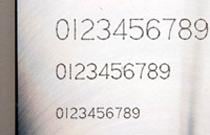
Industrial direct part marking continues to grow in popularity and importance. Traceability and Part Identification are now a part of most product design from very early stages. Government regulations and industry standards groups dictate part marking requirements in just about every industry globally.
What is direct part marking?
A direct part mark is a process used to permanently mark a part. This direct part mark is used for part identification, item level traceability, or for design or aesthetic purposes.
Part identification using a direct part mark is very common for manufactured components. We see this with part numbers, part names, and descriptive text marked on just about any material and type of product.
Part traceability is enabled when a part is marked permanently with a bar code that is machine readable. These marks can range from a UPC code on a consumer product to a laser marked 2D Data Matrix code marked on an aerospace part.
Logos or graphics files can be directly marked onto materials allowing for branding, aesthetic improvements, or schematics such as a circuit diagram. If you can design it using software in most cases the file can be transferred and marked on a part.
Direct Part Marks can essentially be made in one of three ways:
Surface Mark - permanent mark is added to the surface or possibly a slight surface upset
Etched Mark - the surface of the part is disturbed to a noticeable depth with the change in surface properties showing a contrast that becomes the visible mark
Engraved Mark - deeper mark into the surface designed to survive coatings or harsh environments
Direct part marking can either be a graphic (logo, picture, schematic), text, or a machine readable bar code.
What benefits are there to direct part marking?
Unique serial numbers for each part gives the following benefits:
- Warranty fulfillment and confirmation
- Date of manufacture tracking
- Material lot tracking – matching batches of raw materials to finished parts
- Inventory management facilitation
- Assembly assistance – scan a code/enter the serial number and confirm that the correct part was assembled
- Supply chain management – think UPS and FedEx package tracking for your parts
- Quality system management – gather data on the entire manufacturing process
- Service facilitation – customers tell you what part they have and you can troubleshoot issues
- Branding – permanently identify your product with your logo, website, or phone number
- Add schematics to the parts – an arrow for this end up, ’left’ and ‘right’ for orientation, etc.
Find out more about direct part marking.




